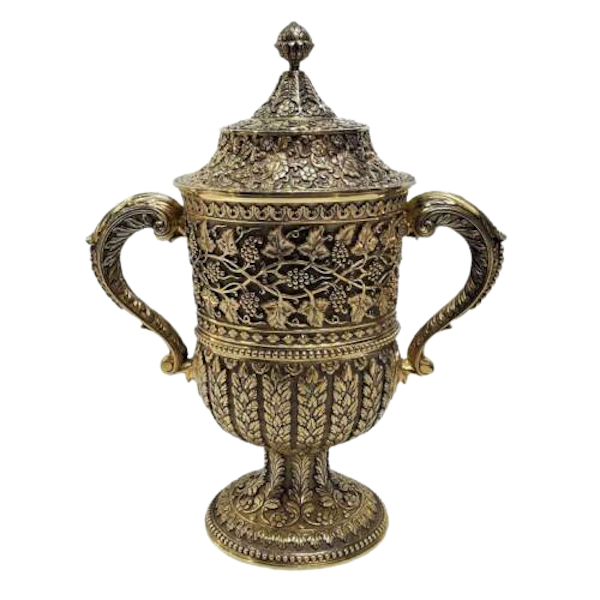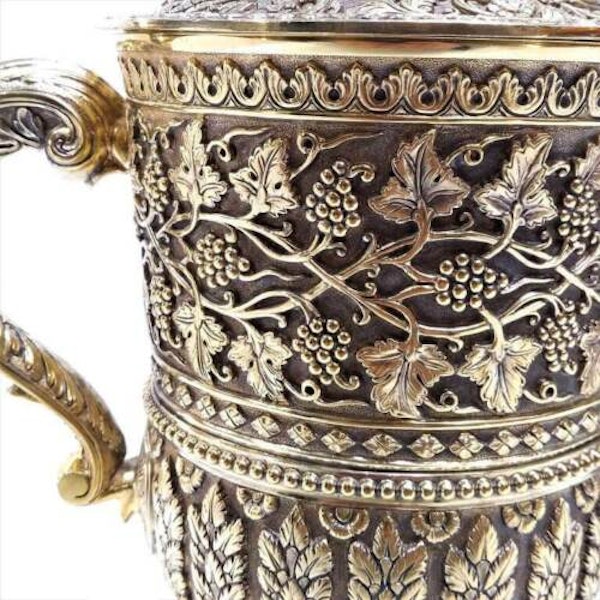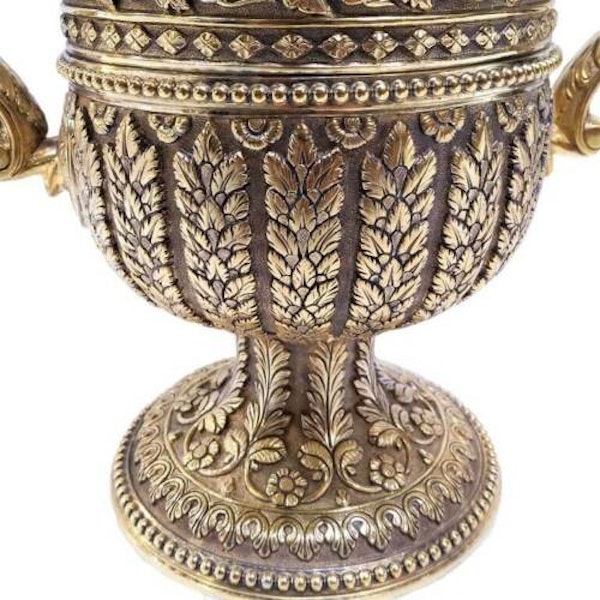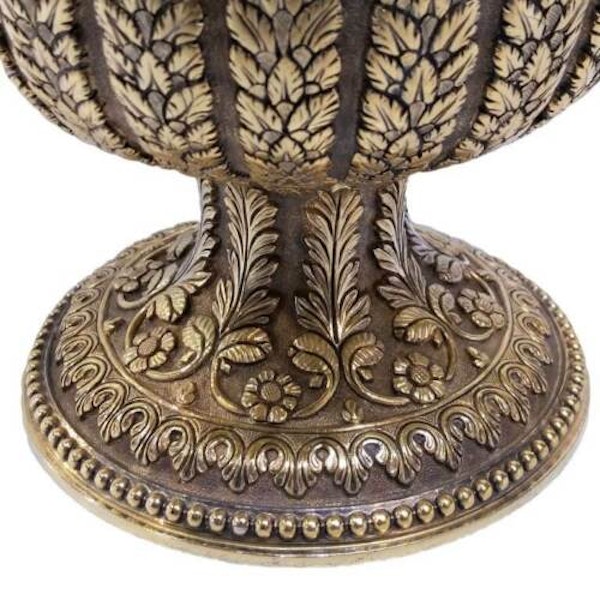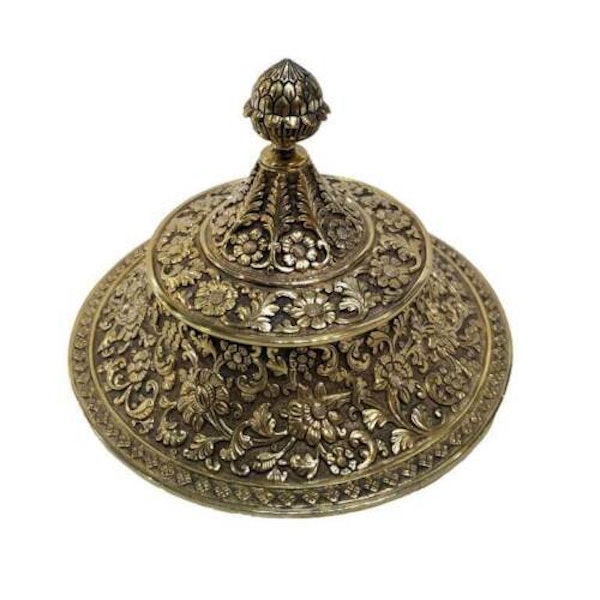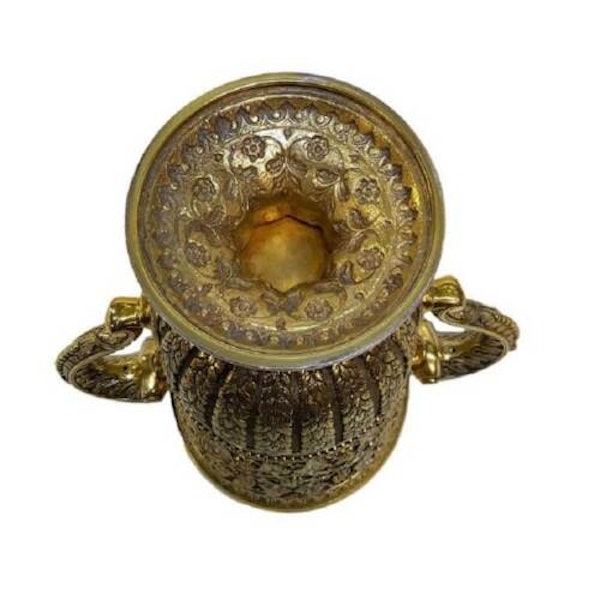Antique English Silver Gilt Cup, Kutch Style, Hancocks & Co - 1870
Antique English Silver Gilt Cup, Kutch Style, Hancocks & Co - 1870
£6,750.00
Description
This splendid silver gilt cup and cover was made by the prestigious firm of Hancocks & Company, which held the Royal Appointment to Queen Victoria, and both pieces bear their full and clear hallmarks showing that the silver was assayed in London in 1870. The cup is in remarkable, original condition and the gilding, to the interior and exterior, is still deep and sumptuous with only the slightest signs of wear or use. The detail is very fine and beautifully crisp and the gauge of metal is very thick.
The form of this cup and cover is European but the ornamentation takes its inspiration from the Indian silver tradition. The design is thought to have been inspired by the completion of the submarine or sub-ocean telegraph cable, by the British Indian Submarine Telegraph Company, which was laid between Cornwall, England and Bombay, India, which opened to the public on 14th March 1870.
This incredible engineering achievement brought about a technological revolution, allowing rapid and reliable communication between the two countries for the first time, strengthening their ties and greatly facilitating trade. A message from England to India would now take between 5 and 10 minutes to arrive in India, which was remarkably fast. Importantly, this enterprise also established new connections with many other countries it passed along the route of the cable, for example, Portugal.
The stepped cover has architectural echoes and is topped by a striking bud finial, underpinned by a row of petals, representing a lotus. It sits above an octagonal spire. The style of the flowers and foliage which ornament the cover are distinctly Kutch in style with the acanthus leaves, a favourite motif of the earlier Mughal dynasty, also used in Kutch silverwork. The prominent handles to either side of the cup are also ornamented with acanthus leaves and Mughal silver handles were frequently ornamented in a very similar way.
The large cup has a deep bowl and stands on a domed foot supported by a thick octagonal stem. The composition is very skilful, with elements repeating at intervals, creating balance, harmony and cohesion. For example, the beaded border to the edge of the foot is repeated just above the point at which the bottom of the handle has been attached to the body and the faceted stem has been balanced by the faceted spire of the cover above.
The ornamentation of the foot and stem, with its acanthus leaf borders, simple flower heads and elongated acanthus leaves to the stem, also follow the Kutch tradition. The ornamentation of the bowl has been divided into two principal panels separated by narrow repeating geometric borders. The upper panel depicts grapes and vine leaves, a universal symbol of conviviality, also part of the Kutch design repertoire. The entwined vines run horizontally around the bowl whilst, in contrast, the sixteen garlands of foliage in the lower panel run vertically from top to bottom, down to the base of the bowl.
The firm of Hancocks was founded on 1st January 1849 by Charles Frederick Hancock, previously a partner of Storr & Mortimer. He opened his first shop at 37 Bruton Street, London, with a manufacturing workshop next door. Only eight months later, they had received the Royal Appointment of Queen Victoria and some spectacular commissions. The firm exhibited at the Great Exhibition of 1851 with an impressive display of silver. Within a short space of time, they had also secured Appointments to the Russian, Italian, Belgian, German, Austrian and Portuguese royal families.
Helped by the firm’s extremely rapid expansion and its Royal Appointments, in 1856 Mr Hancock was also granted the prestigious award of designing and producing the Victoria Cross, which is still made, exclusively, by the company today. This medal was introduced on 29 January 1856, by Queen Victoria, to honour acts of valour during the Crimean War. The first Victoria Cross medals were presented by her in 1857. According to tradition, the metal used to make the medals comes from Russian cannon captured at the Siege of Sebastopol.
The firm was restyled Hancock, Son & Company in 1866 on the semi-retirement of the founder, Charles Frederick Hancock. At the same time, Charles’ son, Mortimer, became a partner, together with Henry Dore and Horatio Stewart. Three years later the company was renamed Hancocks & Company, with C F Hancock retiring completely in the early 1970s after his other son, Charles Frederick Junior, had also joined the partnership. The Hancocks silver mark, to the underside of the base of this cup, was entered on 22nd January 1870.
Around the time that the cup and cover were made, Hancocks exhibited in international exhibitions in Paris in 1867 and Vienna in 1873, where the firm was awarded the Emperor’s gold medal for Science and Art, in addition to the ‘Prize Medal’. Examples of the firm's silverware can be found in many museums and high profile collections.
| item details | |
|---|---|
| Origin | Asian |
| Period | 19th Century |
| Style | Other |
| Condition | Excellent |
| Dimensions | Weight – 1380 grammes |
| Diameter | Height 28.5 cms; Width 22.5 cms |
Product REF: 10049
